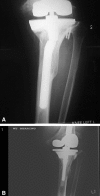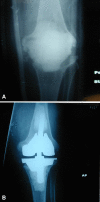Can tantalum cones provide fixation in complex revision knee arthroplasty?
- PMID: 21465329
- PMCID: PMC3237984
- DOI: 10.1007/s11999-011-1888-9
Can tantalum cones provide fixation in complex revision knee arthroplasty?
Abstract
Background: The best method for managing large bone defects during revision knee arthroplasty is unknown. Metaphyseal fixation using porous tantalum cones has been proposed for severe bone loss. Whether this approach achieves osseointegration with low complication rates is unclear.
Questions/purposes: We therefore asked: (1) What is the risk of infection in revision knee arthroplasty with large bone defects reconstructed with porous tantalum cones? (2) What is the rate of osseointegration with these cones? (3) What is the rate of loosening and reoperation? (4) Is knee function restored?
Methods: We retrospectively reviewed 27 patients who had 33 tantalum cones (nine femoral, 24 tibial) implanted during 27 revision knee arthroplasties. There were 14 women and 13 men with a mean age of 64.6 years. Preoperative diagnosis was reimplantation for infection in 13 knees, aseptic loosening in 10, and wear-osteolysis in four. Patients were evaluated clinically and radiographically using the score systems of the Knee Society and followed for a minimum of 2 years (mean, 3.3 years; range, 2-5.7 years).
Results: One knee with two cones was removed for infection. All but one cone showed osseointegration. One knee was revised for femoral cone and component loosening. There was one reoperation for femoral shaft fracture and one for superficial dehiscence. The mean Knee Society pain score improved from 40 points preoperatively to 79 points postoperatively. The mean function score improved from 19 points to 47 points.
Conclusions: Our observations suggest metaphyseal fixation with tantalum cones can be achieved. Longer-term followup is required to determine whether the fixation is durable.
Figures


References
Publication types
MeSH terms
Substances
LinkOut - more resources
Full Text Sources
Medical

